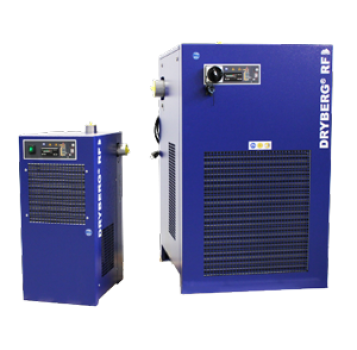Product information "DRYBERG®️ RF22/AC Refrigeration dryer "
Refrigeration dryer DRYBERG®️ RF22/AC equals to DRYPOINT®️ RA1300/AC
In the case of divergent operating pressure: Divide volume flow by factor
In the case of divergent ambient temperature: Divide volume flow by factor
In the case of divergent inlet temperature: Divide volume flow by factor
In the case of divergent pressure dew point: Divide volume flow by factor
Downloads
Manual DRYBERG®️ RF/AC, PDF( Size: 5 MB )
Operating principle of DRYPOINT® RA
In the DRYPOINT® RA refrigeration dryers, the air is dried in a counter-flow process with optimised heat exchange along the entire process path. The air flows in a constant downwards direction with no diversions.
The generously dimensioned counter-flow heat exchanger unit which consists of an air-air and an air-refrigerant heat exchanger, among others, cools the compressed air to a temperature of around 3°C . Therefore the size and design of the heat exchangers promote effective cooling while minimising flow resistance.
Warm compressed air saturated with moisture is pre-cooled in the air-air heat exchanger when it enters the refrigeration dryer (1). Consequently, the refrigerating capacity of the refrigerant needed in the downstream air-refrigerant heat exchanger (2) is reduced. This makes the system more energy-efficient. Gravity supports a very high droplet separation of nearly 99 %. The flow velocity is greatly reduced in the very large condensate collection chamber with subsequent broad return. This reliably avoids any entrainment of droplets which have already been separated (3).
The condensate which is produced is drained from the DRYPOINT® RA through the level-controlled condensate drain BEKOMAT®. This prevents any pressurised air losses and can be treated reliably with processing systems such as the oil-water separation system ÖWAMAT® or the emulsion splitting plant BEKOSPLIT® (4). Before leaving the DRYPOINT® RA, the dried, cold compressed air is re-heated in the air-air heat exchanger. This significantly lowers the relative humidity and recovers BEKOMAT® up to 60% of the refrigerating capacity used (1).
The generously dimensioned counter-flow heat exchanger unit which consists of an air-air and an air-refrigerant heat exchanger, among others, cools the compressed air to a temperature of around 3°C . Therefore the size and design of the heat exchangers promote effective cooling while minimising flow resistance.
Warm compressed air saturated with moisture is pre-cooled in the air-air heat exchanger when it enters the refrigeration dryer (1). Consequently, the refrigerating capacity of the refrigerant needed in the downstream air-refrigerant heat exchanger (2) is reduced. This makes the system more energy-efficient. Gravity supports a very high droplet separation of nearly 99 %. The flow velocity is greatly reduced in the very large condensate collection chamber with subsequent broad return. This reliably avoids any entrainment of droplets which have already been separated (3).
The condensate which is produced is drained from the DRYPOINT® RA through the level-controlled condensate drain BEKOMAT®. This prevents any pressurised air losses and can be treated reliably with processing systems such as the oil-water separation system ÖWAMAT® or the emulsion splitting plant BEKOSPLIT® (4). Before leaving the DRYPOINT® RA, the dried, cold compressed air is re-heated in the air-air heat exchanger. This significantly lowers the relative humidity and recovers BEKOMAT® up to 60% of the refrigerating capacity used (1).
Technical Data of Refrigeration dryer DRYBERG® RF22/AC
| Refrigeration dryer | DRYBERG®️ RF22/AC |
| Volume flow (m3/h) at +3 °C | 1260 |
| Power consumption (kW) | 2,55 |
| Pressure loss (Δp bar [g]) | 0,21 |
| Air connection (ø) | DN80-PN16 |
| Dimensions AxBxC (mm) | 1465x790x1000 |
| Weight (kg) | 242 |
In the case of divergent operating pressure: Divide volume flow by factor
| bar (g) | 4 | 5 | 6 | 7 | 8 | 10 | 12 | 14 |
| Correction factor | 0.77 | 0.86 | 0.93 | 1.00 | 1.05 | 1.14 | 1.21 | 1.27 |
| °C | 25 | 30 | 35 | 40 | 45 | 50 |
| Correction factor | 1.00 | 0.96 | 0.91 | 0.85 | 0.76 | 0.64 |
| °C | 25 | 30 | 35 | 40 | 45 | 50 | 55 | 60 | 65 | 70 |
| Correction factor | 1.27 | 1.21 | 1.00 | 0.84 | 0.70 | 0.57 | 0.48 | 0.42 | Auf Anfrage | |
| °C | 3 | 5 | 7 | 10 |
| Correction factor | 1.00 | 1.09 | 1.19 | 1.37 |
Downloads
Manual DRYBERG®️ RF/AC, PDF( Size: 5 MB )
Login


